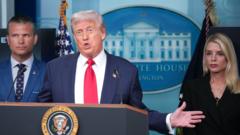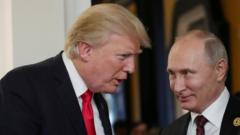Recent declarations by Donald Trump regarding crime in Washington DC starkly contrast with data from local authorities. While the former president stated crime is out of control, statistics reveal significant declines in violent crime and robberies, suggesting a complex picture.
Assessing Crime Trends in Washington DC: Fact vs. Claims
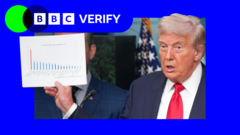
Assessing Crime Trends in Washington DC: Fact vs. Claims
A closer look at the crime statistics in Washington DC amid conflicting statements from former President Trump and local officials.
The debate over crime rates in Washington DC has intensified following remarks from former President Donald Trump, who claimed that crime in the nation’s capital is spiraling out of control. Trump’s comments came as he announced plans to deploy National Guard troops to the city and take charge of its police department during a press conference he deemed “Liberation Day.” However, Mayor Muriel Bowser countered, asserting that the city has experienced a significant decrease in crime, hitting a 30-year low for violent offenses.
Trump’s executive order, which declared a “crime emergency” in the district, cited “rising violence” as a justification for his measures. Nevertheless, statistics from Washington DC's Metropolitan Police Department (MPDC) show that violent crime has declined sharply since it peaked in 2023. Preliminary data for 2025 indicates that violent crime overall has dropped by 26%, while robbery incidents have fallen by 28%.
Although the MPDC's data reflects a steep decline, discrepancies exist between it and FBI statistics. While the MPDC reported a 35% decline in violent crime for 2024, the FBI indicated a lesser drop of 9%. Adam Gelb, CEO of the Council on Criminal Justice, noted that while the figures vary, an unmistakable downward trend in violence has been observed since the peaks of 2023.
Addressing concerns over homicide rates, Trump remarked that murders reached an all-time high in 2023; however, data shows that while the homicide rate did increase in 2023, it was not the highest on record. In fact, the MPDC reported a 12% decrease in homicides in 2024 compared to the previous year. As of mid-August, Washington DC has recorded 99 homicides, including a high-profile case that Trump referenced.
Additionally, Trump pointed to a rise in carjackings, claiming that incidents have more than tripled over five years. Contrary to that assertion, MPDC reports indicate that carjacking offenses are down this year compared to 2024. A citywide curfew aimed at curbing juvenile crime, particularly carjackings, has been in place since July.
When comparing crime rates with other cities, Gelb noted that while violence in Washington DC remains above the average of several major US cities, the decline is in line with trends observed nationwide. The CCJ's analysis suggests a 19% drop in DC's homicide rate in the first half of 2025 compared to the same timeframe the previous year, which slightly outpaces the national average decline.
In conclusion, while claims of rising crime prevail in rhetoric, statistical evidence points towards a reduction in violent offenses and robberies in Washington DC. The contrast between political statements and actual crime trends underscores the complexities in analyzing crime data within urban contexts.
Trump’s executive order, which declared a “crime emergency” in the district, cited “rising violence” as a justification for his measures. Nevertheless, statistics from Washington DC's Metropolitan Police Department (MPDC) show that violent crime has declined sharply since it peaked in 2023. Preliminary data for 2025 indicates that violent crime overall has dropped by 26%, while robbery incidents have fallen by 28%.
Although the MPDC's data reflects a steep decline, discrepancies exist between it and FBI statistics. While the MPDC reported a 35% decline in violent crime for 2024, the FBI indicated a lesser drop of 9%. Adam Gelb, CEO of the Council on Criminal Justice, noted that while the figures vary, an unmistakable downward trend in violence has been observed since the peaks of 2023.
Addressing concerns over homicide rates, Trump remarked that murders reached an all-time high in 2023; however, data shows that while the homicide rate did increase in 2023, it was not the highest on record. In fact, the MPDC reported a 12% decrease in homicides in 2024 compared to the previous year. As of mid-August, Washington DC has recorded 99 homicides, including a high-profile case that Trump referenced.
Additionally, Trump pointed to a rise in carjackings, claiming that incidents have more than tripled over five years. Contrary to that assertion, MPDC reports indicate that carjacking offenses are down this year compared to 2024. A citywide curfew aimed at curbing juvenile crime, particularly carjackings, has been in place since July.
When comparing crime rates with other cities, Gelb noted that while violence in Washington DC remains above the average of several major US cities, the decline is in line with trends observed nationwide. The CCJ's analysis suggests a 19% drop in DC's homicide rate in the first half of 2025 compared to the same timeframe the previous year, which slightly outpaces the national average decline.
In conclusion, while claims of rising crime prevail in rhetoric, statistical evidence points towards a reduction in violent offenses and robberies in Washington DC. The contrast between political statements and actual crime trends underscores the complexities in analyzing crime data within urban contexts.

